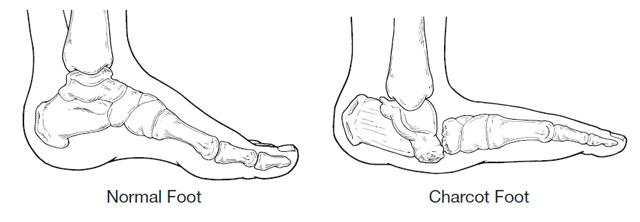19 Mar Charcot Deformity
Charcot foot can occur in a diabetic who has neuropathy (nerve damage) in the foot that impairs the ability to feel pain. Charot foot typically occurs following a minor injury, such as a sprain or stress fracture. The prevalence of Charcotarthropathy ranges from 0.1% to as high as 13%. In patients with diabetes, the incidence of acute Charcot arthropathyof the foot and ankle ranges from 0.15-2.5%. Epidemiologic studies do not distinguish between acute and postacute disease. Bilateral disease occurs in less than 10% of patients. Recurrence of disease occurs in less than 5% of patients. Some studies indicate that men and women are equally affected, while others report a 3:1 predilection for males.
Because the patient doesn’t feel the injury, he or she continues to walk, making the injury worse. Bones fracture, joints collapse and the foot becomes swollen, red and deformed. The patient continues to walk on the deformed foot because they do not feel any pain. The continued abnormal forces on the deformed foot result in serious ulcerations which can require amputation. As the disorder progresses, the joints collapse and the foot takes on an abnormal shape, such as a rocker-bottom appearance.
Charcot foot is a very serious condition that can lead to severe deformity, disability, and even amputation. Because of its seriousness, it is important that patients with diabetes—a disease often associated with neuropathy—take preventive measures and seek immediate care if signs or symptoms appear. The obesity epidemic is increasing the incidence of Charcot foot. The excess weight increases the risk of developing diabetes. Once the patients has diabetes, nerve damage to the feet can result. Nerve damage combined with obesity can then lead to micro trauma on the bones which in turn causes Charcot joint to develop. San Antonio has one of the highest incidence of diabetes and obsesity in the country. Podiatrist in San Antonio are all to familiar with the common presentation of Charcot foot to their office.

Symptoms and Treatment
The symptoms of Charcot foot may include:
- Warmth to the touch (the affected foot feels warmer than the other)
- Redness in the foot
- Swelling in the area
- Pain or soreness
The goal of podiatric Charcot foot treatment is to stabilize the joint. In patients with diabetes avoiding placing weight on the foot for at least 8 weeks may help to prevent further damage. During this time, a total contact or walking cast and crutches may be required to protect the foot.
Traditional surgical techniques, in which bones are held in place by internal plates and screws, don’t work with a subset of obese Charcot patients. Their bones, already weakened by complications of Charcot foot, could collapse under the patient’s heavy weight.
A common podiatric treatment in such cases is to place the patient in a fiberglass cast. But bones can heal in deformed positions. And, it is difficult or impossible for obese patients to walk on one leg when the other leg is in a cast. Patients typically have to use wheelchairs and are confined to the first story of the house for as long as nine months. And after the cast comes off, they must wear a cumbersome leg brace.
By contrast, patients who are treated with an external fixator often are able to walk or at least bear some weight on the treated leg. The device is attached to the leg for only two or three months.

